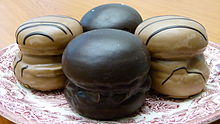Mohrenkopf (pastries)
The term Mohrenkopf (also Othello or chocolate ball ) is used for various small pastries . The term "Mohrenkopf" (head of a Moor ) is a translation of the French Tête de Nègre and was first documented in Leipzig in 1892 . It is a pastry made from Othello paste ( biscuit ) that is filled and coated with chocolate or couverture . In some areas of the German-speaking area, it is called the chocolate kiss . The term “Angels' head” is also used in English.
History of origin
The Mohrenkopf in this form is considered to be an invention of Leipzig bakers at the end of the 19th century. The universal encyclopedia of culinary arts , which has been published regularly in Leipzig since 1878, was familiar with Mohrenköpf and also called it Indian donuts . Accordingly, sugar was whipped into a thick foam with egg yolks and the solid snow made of egg white and wheat or potato flour was mixed in. Small, round piles of this mass were quickly baked on paper, two of them put together using spread jam and dipped in a chocolate glaze.
In 1899, Adolf Cnyrim recorded his recipe in his book Das Bäckergewerbe der Neuzeit . The pastry consists of a biscuit mass , also called Mohrenkopf or Othello mass. It consists of sugar, egg yolk, flour and egg white. The mixture is hemispherical on greased and floured trays or special carrot trays and then baked.
The original form consists of two halves, which are put together with jam and coated with dark chocolate. This is supposed to imitate the applied hairstyle of African peoples, comparatively the image in the Corsican coat of arms can serve as a form.
In the works of Dudenverlag , the expression Mohrenkopf has been provided with the note since 2012 that it is often perceived as discriminatory, in more recent it is marked as out of date and discriminatory.
variants
In Austria, southern Baden-Württemberg and Switzerland, Mohrenkopf is also a biscuit biscuit in the shape of a three-quarter ball that is filled with whipped cream or egg cream and coated with chocolate. In Germany, the pastries are usually filled with vanilla pudding, also vanilla or nougat cream, more rarely with whipped cream and coated with chocolate. Variants that are coated with colored frosting are common. During the carnival season, the Moor's heads are decorated in a particularly colorful way. The term "negro head" used in Germany was sometimes used in the past, but this term was increasingly abandoned in the 1980s and 1990s.
Individual evidence
- ↑ a b Waldemar Ternes , Alfred Täufel, Lieselotte Tunger, Martin Zobel (eds.): Food lexicon . 4th, comprehensively revised edition. Behr, Hamburg 2005, ISBN 3-89947-165-2 .
- ↑ Manfred Weißbach (Ed. From Hotel Merkur Leipzig): Kochkunst . Verlag für die Frau, Leipzig 1985, ISBN 3-7304-0001-0 .
- ↑ a b IREKS Arkady Institute for Bakery Science (ed.): IREKS ABC of the bakery. 4th edition. Institute for Bakery Science, Kulmbach 1985
- ↑ Universal encyclopedia of culinary arts . Publishing bookstore by JJ Weber, Leipzig 1886, 3rd edition. Keyword: Mohrenköpf, 2nd volume, p. 155. Keyword: Indianer Krapfen, 1st volume, p. 475
- ^ The large dictionary of the German language, 4th edition, Mannheim 2012; The German spelling, 26th edition, Berlin 2013.
- ↑ German Universal Dictionary, 9th edition, Berlin 2019; Duden online , accessed on August 5, 2020.
Web links
- Mohrenkopf (Confectionery) in the database of Culinary Heritage of Switzerland


